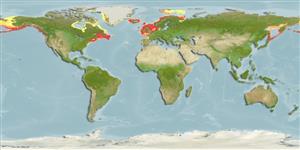Gastropoda |
Littorinimorpha |
Littorinidae
Environment: milieu / climate zone / depth range / distribution range
Ecology
Benthic; depth range 0 - 200 m (Ref. 83435). Polar; 78°N - 34°N, 141°E - 42°E
Northern Atlantic, Northern Pacific and the Arctic: from Japan to Alaska and California, and north to Svalbard. Circumpolar to subtropical.
Length at first maturity / Size / Weight / Age
Maturity: Lm ? range ? - ? cm Max length : 1.3 cm DL male/unsexed; (Ref. 83435); max. reported age: 1.00 years (Ref. 8702)
Maximum depth from Ref. 118693. To 1.6 cm in size (unit not given) (Ref. 95344). Found on rocky shores along the intertidal zone. Abundant in some areas (Ref. 95344). Mesograzer (Ref. 118689). Feeds and lives on a variety of macroalgae in rocky subtidal zone, including Fucus distichus edentatus, Chondrus crispus, Fucus serratus, Mastocarpus stellatus and Laurencia pinnatiada. Exhibits seasonal abundance in kelp habitats, where it dominantly feeds on Laminaria saccharina (Ref. 118682), Macrocystis integrifolia and Nereocystis luetkeana (Ref. 118689).
Life cycle and mating behavior
Maturity | Reproduction | Spawning | Eggs | Fecundity | Larvae
Members of the order Neotaenioglossa are mostly gonochoric and broadcast spawners. Life cycle: Embryos develop into planktonic trocophore larvae and later into juvenile veligers before becoming fully grown adults.
Dahl, L. 2002. (Ref. 3140)
IUCN Red List Status (Ref. 130435)
CITES status (Ref. 108899)
Not Evaluated
Not Evaluated
Threat to humans
Human uses
| FishSource |
Tools
More information
Age/SizeGrowthLength-weightLength-lengthMorphologyLarvaeAbundance
Internet sources
Estimates based on models
Preferred temperature
(Ref.
115969): 5.7 - 12.5, mean 9.9 (based on 304 cells).
Price category
Unknown.
